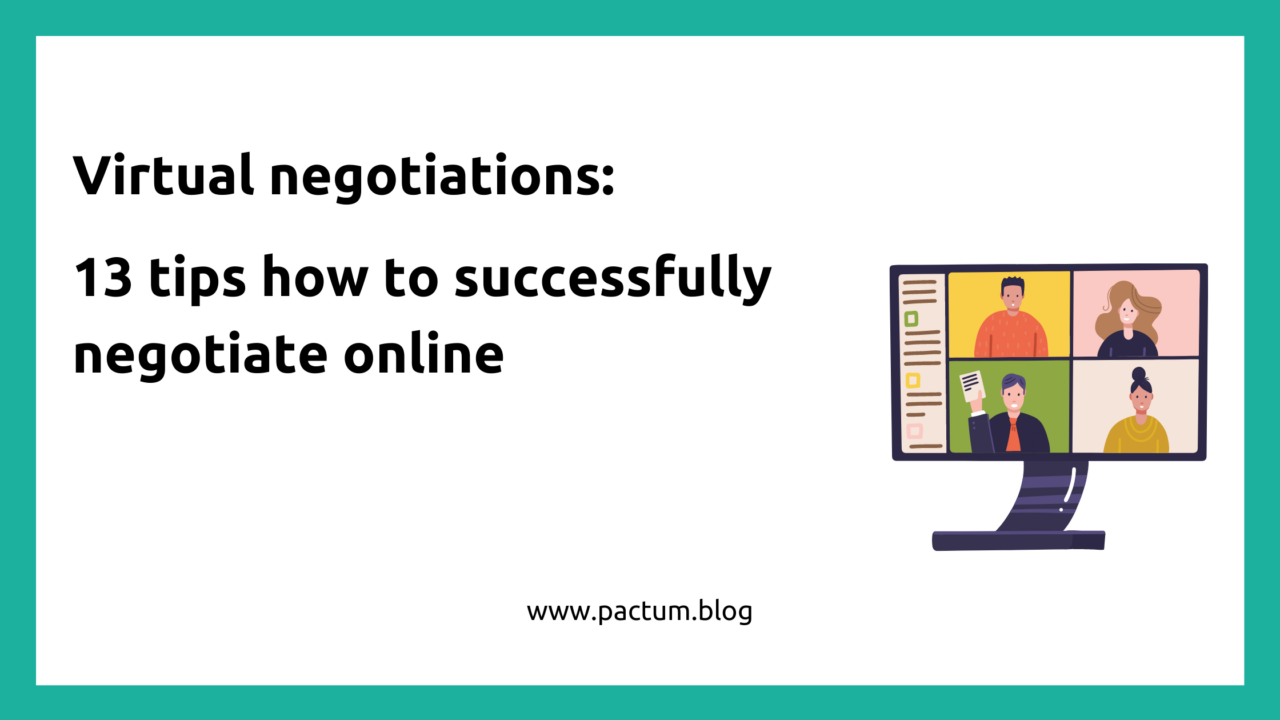Online negotiations: 13 tips how to successfully negotiate online
Since the beginning of the COVID-19 pandemic, face-to-face meetings have become increasingly rare. The pandemic is changing our meeting culture and with it our way of negotiating. But that is no reason to worry. Because: virtual negotiations are not worse – they are different. If the differences in virtual communication are taken into account, virtual negotiation is also fun and delivers good results. How? You can read about that in today’s article.

Why negotiating in video conferences is different
Are you completely exhausted in the evening, even though you hardly moved during the day and “only” took part in virtual meetings? You are like many people at the moment. What you are experiencing even has a name: zoom fatigue.
The term zoom fatigue is a combination of the name of the American software manufacturer “Zoom” and the English term for tiredness or exhaustion. This refers specifically to the fatigue that we experience as a result of video conferences and virtual meetings.
It doesn’t matter whether you use Zoom, Microsoft Teams, Google Hangout or Facetime. The effect is always the same:
We are stressed
Who hasn’t experienced it? The technology goes on strike and we are late for a video conference. We are already annoyed before it starts. The more people there are in a session, the more faces you see in parallel. The human eye registers every movement. Our brain tries to process every piece of information. This stresses us even more.
We are distracted
Our surroundings in zoom calls are distracting. A child calling loudly in the background. The man walking through the picture. The light that dazzles. Everything is transmitted. It lightens the mood. But it also demands our attention and stresses us.
We are constantly online and forget to take breaks
There is almost no possibility to take a mental break during a video conference. We are “always on” during the session. In analogue meetings, such breaks occur automatically. In the worst case, we use the time in the home office to participate in online meetings without interruption in order to work “efficiently”. This doesn’t even leave any breaks between the individual appointments. But it is precisely these breaks that we need in order to adjust to the new topic.
We are uncertain
In video conferences, our perception is technically limited. People appear as “talking heads”. We concentrate on facial expressions. Because it is impossible to read the gestures and body language of the other person. In addition, we do not see what is happening outside the frame. Unconsciously, we wonder if something is being hidden from our view, if there might even be another person in the room. You are not sure whether the conversation might not be secretly stored or transmitted to additional participants. This changes the climate of the conversation dramatically. There is mistrust in the negotiations. A glass negotiating room is created.
We talk at cross purposes
Active listening is important in negotiations to understand the interests of your counterpart. But this does not work optimally in video conferences: the sound quality is not consistently good and individual words or sentences are lost. In addition, there is latency, which delays answers. As humans, we are used to getting answers to our questions. If this doesn’t happen, we ask questions, shout in between or interrupt each other.
The above indications probably already make it clear to you: the virtual context makes negotiating more cumbersome, slower and creates more misunderstandings. You need more time to build trust and to align your interests.
13 tips how to successfully negotiate online
Tip #1: Limit virtual sessions
The formats that work in the analogue environment cannot be replicated one-to-one online. To avoid zoom fatigue, it is much better to turn a negotiation that would have originally lasted one day into two online sessions of 4 hours each.
Tip #2: Ensure working technology
To get through the meeting smoothly and thus avoid unnecessary misunderstandings, ensure a stable internet connection for all participants. Test your video conferencing system in advance. Play through all the functions. Does the screen sharing work? Is the session password protected? Can you manage the waiting room? Ask your counterpart for a joint technology check in advance.
Tip #3: Minimize security risks
Nowadays, any kind of negotiation can be easily recorded with your smartphone. It doesn’t matter whether you are negotiating on the spot, by phone or by video conference. You can never be 100 per cent sure that this will not happen. Nevertheless, it is important to minimise any risks. To do this, I recommend that you compare the different tool providers in advance and, if necessary, ask your IT department for advice. In addition, you should agree at the beginning of the negotiation that no recordings or recordings of any kind will be made. I recommend that you put these rules in writing.
Tip #4: Make small talk
Start your negotiation session with a casual conversation. The background of your counterpart offers you enough points of reference (pieces of furniture, pictures, etc.). Common ground creates a good mood.
Tip #5: Set communication rules
Have a conscious conversation at the beginning of the virtual negotiation about how they want to talk to each other. Get the participants’ agreement to refrain from multitasking during the entire session. As the facilitator, regularly summarise the current state of the negotiation. Structuring the session into thematic blocks helps all participants to keep an overview.
Tip #6: Turn on your camera
Actually a no-brainer! But I still experience that participants leave their camera switched off. This behaviour is doubly damaging: on the one hand, it gives the speaker a strange feeling because he/she doesn’t know what the other person is actually doing. On the other hand, “not being seen” promotes inattention on the part of the listener and tempts multi-tasking. Therefore: Turn on your webcam.
Tip #7: Ensure internal communication amongst your team
This tip is one of my insider tips because the necessity is almost never recognised. If you and your team are sitting in the home office because of the current restrictions, your internal team communication is limited. At the same time, you need a connection with your colleagues to tactically coordinate everything you observe during the negotiation. Therefore, set up a parallel communication channel. I advise you not to use the chat of the videoconferencing system, because it is easy to make mistakes here and your counterpart may then be able to read internal information. Establish another channel: For example, set up a group in a messenger service like Slack. If everyone has the mute function on their mobile phone under control, you can also keep in touch by phone.
Tip #8: Keep eye contact
Looking into the eyes of your counterpart builds trust. Trust is important to develop good agreements in negotiations. Therefore: Don’t look at yourself. If you find it difficult to look directly into the camera, I recommend positioning the gallery view of the other participants at the top of the screen. This way, you will intuitively look towards the top of the screen more often. If you want to go even further, you can also use software solutions such as NUIA. This solution uses eye tracking to help you make eye contact. Microsoft now even offers the “Eye Conact” feature on new Surface devices, which uses artificial intelligence (AI) to correct your gaze during video calls.
Tip #9: Broaden the field of vision
You can reduce the illusion of the talking head by asking participants to move away from the camera. If your own image distracts you, turn off this view as well. You will then no longer see yourself. The other participants will still see them.
Tip #10: Plan active breaks
We can concentrate in the virtual setup for a maximum of 45 minutes. Plan short breaks so that participants can mentally switch off and move around. Suggest consciously turning off the camera and sound during the breaks. Ask participants to get a coffee or make a cup of tea.
Tip #11: Use co-moderation
You already know: participating in video conferences is exhausting. But what is even more tiring is moderating the session. That’s why you should relieve yourself and team up with a colleague. Co-moderation not only relieves you, but also helps the participants to listen better.
Tip #12: Visualise core content
Video conferencing limits your visibility. Use collaborative tools such as Miro, Padlet or Mural to display the most important content for all to see. Such tools are useful for developing ideas for solutions. They can also be used to prioritise the different negotiation points. The great thing about these tools is that they can work together with the other participants on the virtual whiteboards. This increases the participants’ attention and strengthens interaction.
Tip #13: Summarise key points
Ideally, you have used one of the tools mentioned above to record the most important intermediate results of your negotiation. If not, summarise the current status in an email and send it to all participants immediately after the session. Ask to review and confirm your minutes. This will help you avoid unnecessary misunderstandings.
Conclusion
The pandemic will pass. But I am convinced: we will increasingly negotiate virtually. Therefore, use the current situation to practise online negotiating and try out different tools. Be aware: online negotiating is not worse. It is different.
